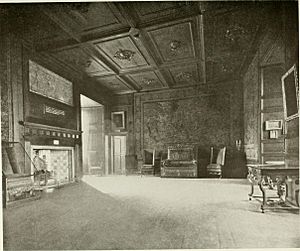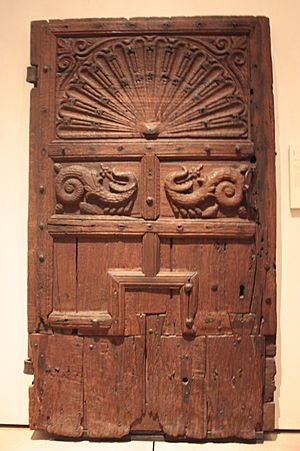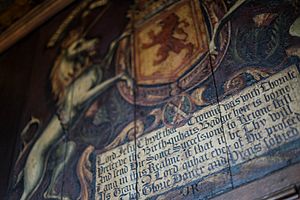Domestic furnishing in early modern Scotland facts for kids
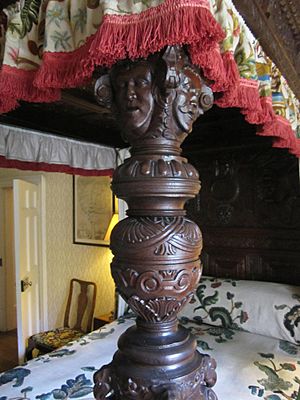
Imagine what homes were like in Scotland a long, long time ago, between the late Middle Ages and early modern times. The furniture and decorations were either made right there in Scotland or brought in from places like Flanders (now part of Belgium) and France. We don't have many actual pieces of furniture left from those days. But we know a lot about them from old lists called "inventories" and "wills." These old papers, often written in the Scots language, tell us what wealthy and noble people had in their homes. For example, we know a lot about the fancy fabrics and beds that belonged to Mary, Queen of Scots. Many Scottish wooden furniture pieces were carved with the initials of married couples.
Contents
Finding Out About Old Furniture
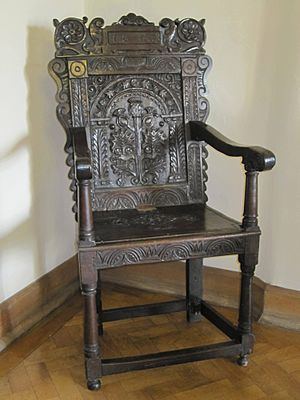
Historians learn about old Scottish furniture by looking at "inventories." Think of these as detailed shopping lists or records of everything someone owned when they died. These lists help us understand what homes looked like centuries ago.
For example, a dressing room at Drumlanrig Castle for the Duke of Queensbury had a very modern (for its time!) toilet. It was a special seat inside a wooden box with pipes for water.
New furniture workshops started in Edinburgh. They made things like chairs with cane backs and seats. There were also people who made mirrors and even painted furniture in a style called "Japan style."
Many famous people collected old Scottish furniture. These included the writer Walter Scott and the artist Joseph Noel Paton. Paton's father even found a cradle near Linlithgow Palace that people thought belonged to Mary, Queen of Scots. He bought it, but it was later found to be much newer than her time.
Today, you can see old Scottish furniture at places like Provand's Lordship in Glasgow, thanks to William Burrell who donated his collection. The National Museum of Scotland has a special chair called a "caquetoire." It has the initials and star symbol of Annabell Murray, Countess of Mar, who lived at Alloa Tower.
Beds: More Than Just for Sleeping
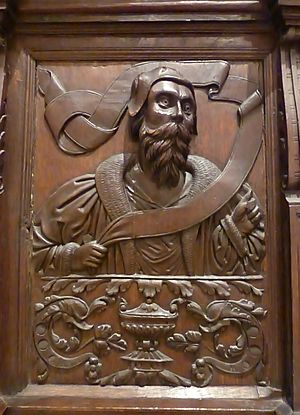
There were many different kinds of beds in old Scotland. A beautiful carved bed at Crathes Castle is one of the few 16th-century beds still around. It has the initials of the Burnett family.
Some beds were called "stand beds." These were free-standing wooden structures with tall posts. James VI had one made of painted walnut wood.
Kings like James IV had "tursing beds" that could be packed up and moved easily when they traveled. James V even had a bed for his ships! When he married Madeleine of Valois from France, her father, King Francis I, gave them amazing wedding gifts. These included fancy tapestries and three rich beds with silk and gold curtains.
Hidden Beds and Low Beds
Some beds were built right into the wall panelling, like a cupboard. These were called "kaissit" or "close beds." You can still see one at Craigievar Castle, though it's now used for a bathtub! These box-beds were common in Scottish homes for a long time.
A "laich" or low bed was a simple bed without a canopy or posts. Some could even be tucked away under a bigger bed.
The best beds were covered with expensive and beautifully embroidered fabrics, with lots of fancy trimmings. For example, a valance (a decorative strip of fabric around the top of bed curtains) belonging to Colin Campbell of Glenorchy and Katherine Ruthven showed Adam and Eve. This piece is now at the Burrell Collection.
Mary, Queen of Scots' Beds
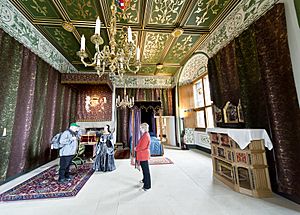
When Mary, Queen of Scots came back to Scotland from France, she brought some furniture from the French royal palaces. Her beds and furnishings were carefully listed in inventories. Many of these items were old, from her father James V's time, and had been stored in Edinburgh Castle. Mary's French staff also made new beds and updated old ones.
Once, Mary almost had a terrible accident at Stirling Castle when a candle set her bed curtains on fire! Another time, a French poet named Chastelard was found hiding under her "Great Bed" at Rossend Castle.
Mary's half-brother, James Stewart, had a "standing bed" made of oak in 1562. The craftsman who made it was called Schange.
Changing Bed Fashions
Fancy fabric beds, often with canopies hanging from the ceiling, were sometimes called "chapel beds." Mary, Queen of Scots took some of these beds from Huntly Castle in 1562 and had them sent to Holyroodhouse. She then ordered her servant to update them with new fabric to match the latest styles.
Mary's own "chapel bed" of red damask was taken apart in 1566. Its beautiful fabrics were used to decorate other beds. These beds were named after their embroidered designs, like the "Bed of Amity" or the "Bed of Phoenix." These beds were often updated for important events, like the baptism of her son, Prince James, at Stirling Castle.
Beds and the Kirk o'Field Mystery
When Lord Darnley was staying at a house in Kirk o'Field in 1567, Mary, Queen of Scots, had a new black velvet bed brought for him. But after a few nights, she had it replaced with an older purple bed. She said it was because the steam from his bath might ruin the new one. She had a green bed for herself in a room downstairs. These changes were later talked about a lot after Darnley was found dead.
Later Royal Beds
After Scotland and England joined under one king in 1603, some rich Scottish nobles started buying furniture from London. They wanted to copy the styles popular at the court of Anne of Denmark, the queen. For example, Anne Livingstone, Countess of Eglinton, asked for a "resting chair" (a type of couch) like one owned by a leading court lady.
Some noblewomen also made their own furnishings. In 1642, Jean Ross, Lady Innes, wrote to her mother that she was making a bed and decorating rooms for a visit from the Earl of Moray. She said the Earl was "very curious" about how rooms were decorated. Her new bed's curtains were made from "sad green serge" (a wool fabric) from her own farms.
Tables and Chairs
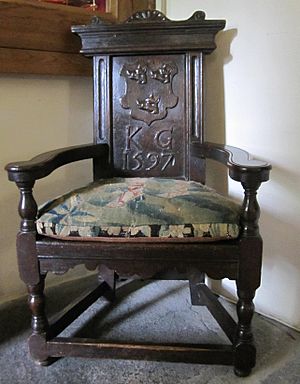
Dining tables were called "meit boards." "Meit" was the old word for food, not just meat. Some tables stood on simple trestles, while others had more solid frames. In the main hall of a castle, there was usually a "high table" for the lord and his family. Other tables, called "syde boards," were for the rest of the household and servants.
Rich diners would have a "cupboard" in the hall. This wasn't always a piece of furniture, but often meant a display of silver plates and cups on shelves covered with fine linen cloths. Drinks were served from here.
Seating included "buffet stools" and "backed stools," which we would now call chairs. The most important chairs at the high table for the lord and his wife were often large and fancy. They were sometimes in a style called "caquetoire," which was influenced by French designs. These chairs often had the owner's initials carved into them.
For cooking, a kitchen table was called a "dressing burd." Wealthy people also had "drawing-tables" that could be made longer by pulling out extra leaves.
By the 1630s, some very rich women, like Mary Sutton, Countess of Home, had marble-topped tables and fancy gilded chairs in their townhouses. These chairs were bought in London and were in the "Italian fashion." As styles changed, her daughter later had these chairs painted green to use in the garden!
Kitchen and Pantry
Kitchens had special furniture too. A "cup almery" was a kind of kitchen dresser. Old wills mention pewter jugs standing on these.
In 1572, the kitchen of Regent Mar had a big pot for salted beef and smaller pots for stews. The pantry was where tablecloths and napkins were kept. Napkins were provided in different qualities depending on how important the diner was. Much of the linen came from a town called Tournai (in modern-day Belgium), so it was called "Dornick." Linen made in Scotland was called "Scoittis dorneik."
The kitchen also had spits for roasting meat, racks, and ladles. There was even a special spit for roasting hare and a cage for poultry. The pantry had shelves, tables, and storage chests.
Homes also had "spice houses" and "larders" for storing food. Female servants often worked in areas called "womanhouses." These spaces were used for many tasks, like spinning wool, doing laundry, and making dairy products. At Aberdour Castle, the womanhouse even had combs and spinning wheels. These womanhouses often had beds for the women who worked there.
Toilets: Close Stools
Latrines built into castle walls can still be seen in old ruins like Dirleton Castle and Falkland Palace. But in the 1500s, people also used portable toilets called "close stools" or "stools of ease." These were like boxes with seats, holding a basin that servants would empty and clean.
Royal close stools were very fancy! They were covered with rich fabrics like velvet and placed in a bedroom, sometimes even under a special canopy hanging from the ceiling. James V had canopies of green or red damask for his.
Mary, Queen of Scots had several close stools. Some were covered with green, purple, or yellow velvet, and one was covered in leather. They all had metal basins inside. She even had a canopy of yellow silk that could be used over a bed or a close stool.
Tapestries and Wall Hangings
Walls in important rooms were often decorated with beautiful tapestries or other hangings. James IV had his bedroom hung with scarlet velvet.
The tapestries used in Scottish royal palaces are well-known. At Stirling Castle, the king's hall had five pieces of tapestry and a red damask canopy. Other rooms had tapestries showing stories like the "Triumph of Verity" or the "History of Roboam." The famous "The Hunt of the Unicorn" tapestries were also displayed there. Today, new versions of these unicorn tapestries have been made for Stirling Castle.
Some rich nobles also owned tapestries. In 1617, when King James VI returned to Scotland, he brought many furnishings for his palaces. People joked that all the best old tapestries in London were sent to Scotland, and that German tapestry makers were asked to make new ones that looked old, so Scotland would seem to have had them for a long time!
New tapestries were ordered in the 1630s, some showing stories like "Julius Caesar." The Marquess of Montrose had several sets of tapestries at Mugdock Castle in 1669, including scenes from the "Story of Abraham" and "forest work" designs.
Besides tapestries, rooms were also decorated with patterned cloth called "Arras works." These were cheaper than real tapestries. In 1561, a room at Holyrood Palace for Mary, Queen of Scots was lined with a fabric called "Paris Green."
Ceiling Decorations and Carvings
The ceilings of important rooms were often beautifully decorated. At Stirling Castle, a chamber ceiling was carved with round shapes holding portraits of famous historical and legendary people. These carvings are called the "Stirling heads." They were made around 1540, possibly by a French craftsman. Today, you can see them at Stirling Castle, and some are in the National Museum in Edinburgh.
Other carved roundels with coats of arms (family symbols) of Mary of Guise and Henry II of France were found in an old house in Edinburgh. These might have been from a place where Mary of Guise stayed.
In the 1600s, decorative wooden panels and plaster ceilings became popular. Traveling craftsmen used wooden molds to create designs. You can see similar carved heads of the "Nine Worthies" (famous heroes) at different castles like Balcarres House and Craigievar Castle. Ceilings also featured Scottish symbols like thistles, harps, and Tudor roses.
Stained-glass windows with coats of arms were also popular. And for security, windows often had strong iron grills called "yetts."
Craftsmen and Merchants
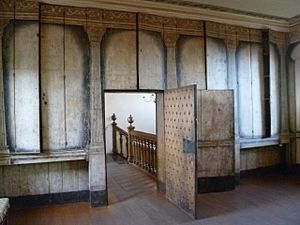
The royal family bought many items for their homes. They bought textiles and tapestries from Flanders using merchants from Edinburgh and Italy. Sometimes, imported goods weren't paid for, and these debts are mentioned in old wills. A merchant named John Clerk in the 1600s imported furniture from France and sold goods to rich clients from his shop in Edinburgh.
Many craftsmen worked for the royal household. Some furniture was even made inside Edinburgh Castle by the same people who worked on the royal cannons! In 1552, a wood-turner in the castle made chair legs and bed posts.
Mary, Queen of Scots had a French craftsman named Nicolas Guillebault in her household. He was an upholsterer, meaning he covered furniture with fabric. He covered chairs, folding stools, and close stools with velvet and leather. These updates were often done for important events like the Baptism of James VI.
Craftsmen in Scottish Towns
In Scottish towns, craftsmen like woodworkers (called "wrights") formed groups called "incorporations." These groups made sure that apprentices learned their skills well and became master craftsmen. They also took part in town parades and celebrations. The oldest business records from a Scottish furniture maker are from a Perth craft group in the 1600s.
Painted Rooms
Besides tapestries, walls and ceilings were often painted with beautiful designs. Artists like Walter Binning and the Warkman family created these "painted friezes and ceilings." In the 1600s, plaster ceilings with decorative designs became very popular.


